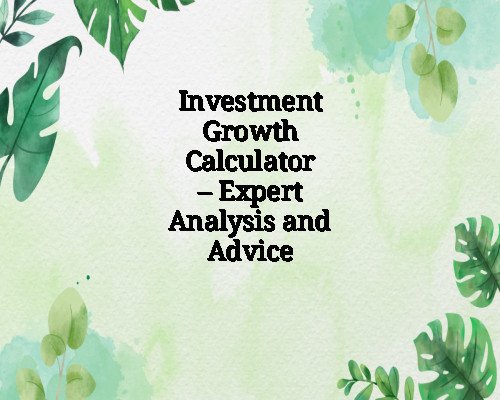Investment Growth Calculator – Expert Analysis and Advice
Track your financial future and reach your goals faster with an investment growth calculator that offers clear insights, projections, and strategic guidance.
Understanding Investment Growth: The Basics
Before diving into the functionalities of an investment growth calculator, it’s crucial to understand what investment growth truly means. In personal finance, investment growth refers to the increase in the value of your invested money over time. This growth is typically fueled by:
-
Compound interest
-
Market appreciation
-
Reinvestment of dividends or capital gains
Even modest contributions can snowball significantly with the power of compounding, especially over long periods. This is where an investment growth calculator becomes invaluable.
What Is an Investment Growth Calculator?
An investment growth calculator is a financial tool designed to project the future value of your investments. By entering specific inputs like initial amount, interest rate, time period, and frequency of contributions, users can estimate how much their investment may grow.
Common Inputs Used:
-
Initial investment – the starting amount
-
Monthly or yearly contributions
-
Expected annual return rate (APY or ROI)
-
Investment duration in years
-
Compounding frequency – annually, semi-annually, quarterly, monthly, or daily
Outputs You’ll Receive:
-
Future value of your investment
-
Total amount contributed
-
Total interest earned or growth
-
Graphical representations of growth over time
The Power of Compound Interest
One of the most impactful components of investment growth is compound interest. Unlike simple interest, compound interest earns “interest on interest,” meaning your gains grow exponentially over time.
Formula:
FV = P × (1 + r/n)^(nt)
Where:
FV = Future Value
P = Principal Investment
r = Annual Interest Rate
n = Number of times compounded per year
t = Time (in years)
For instance, a $10,000 investment with an annual return of 7%, compounded monthly for 20 years, will grow significantly more than a similar investment with simple interest.
How to Use an Investment Growth Calculator Effectively
1. Be Realistic with Returns
Avoid overestimating annual returns. Most financial advisors recommend using conservative estimates like 5% to 8% for stock-based portfolios.
2. Factor in Inflation
An expert approach involves adjusting returns to reflect real growth after inflation. A nominal return of 7% may only be a real return of 4% if inflation is at 3%.
3. Increase Contributions Gradually
Simulate scenarios where you increase contributions annually to reflect raises or side income growth. This helps in visualizing accelerated wealth building.
4. Consider Tax Implications
While calculators often show gross returns, remember that real-life investment growth may be subject to capital gains tax, dividend taxes, or retirement account rules.
Strategic Insights from Financial Experts
Start Early
One of the most consistent pieces of advice from personal finance experts is to start investing as early as possible. Time is your greatest asset. The earlier you start, the more your money benefits from compound interest.
Stay Consistent
Even in volatile markets, sticking to a regular investment schedule (e.g., monthly contributions) is better than trying to time the market.
Diversify Investments
Don’t rely on a single asset class. Diversifying your portfolio with stocks, bonds, mutual funds, ETFs, and even real estate can reduce risk and potentially increase returns.
Reinvest Dividends
Many calculators allow you to toggle reinvested dividends. Experts strongly recommend reinvesting dividends to boost compounding effects.
Sample Investment Scenarios Using a Growth Calculator
Scenario 1: Starting Early
-
Initial investment: $5,000
-
Monthly contribution: $200
-
Annual return: 7%
-
Duration: 30 years
Outcome:
Your investment grows to over $240,000, with around $72,000 in total contributions and $168,000 in investment gains.
Scenario 2: Starting Late but Contributing More
-
Initial investment: $10,000
-
Monthly contribution: $500
-
Annual return: 7%
-
Duration: 15 years
Outcome:
Your investment grows to approximately $176,000, which is still significant—but lower than the early start scenario due to reduced time.
Using an Investment Growth Calculator for Retirement Planning
If you’re saving for retirement, growth calculators can help estimate:
-
How much you’ll have by your retirement age
-
Whether you’re on track for your financial goals
-
How different return rates impact your future nest egg
Example: Retirement Target Calculation
Let’s say you want $1 million by age 65. By using an investment growth calculator, you can determine:
-
How much you need to contribute monthly starting at age 30
-
The impact of expected returns (e.g., 6% vs 8%)
-
What happens if you delay saving by 5 or 10 years
This allows you to make smarter decisions today that benefit your financial future.
Best Practices When Comparing Calculators
There are countless online investment growth calculators, but not all are equally robust. Look for ones that:
-
Allow detailed input customization (e.g., compounding frequency)
-
Offer visual graphs
-
Include inflation and tax estimates
-
Let you compare multiple scenarios side by side
Top options include those offered by reputable financial platforms and personal finance blogs that align with sound financial principles.
Common Mistakes to Avoid
Overestimating Returns
Too many people plug in unrealistic return rates like 12% annually, skewing their expectations. Always err on the conservative side.
Ignoring Fees
Investment fees, even small ones (like 1% annually), can erode long-term growth significantly. Always factor in potential fund or advisor fees.
Short-Term Focus
An investment growth calculator is most effective for long-term projections. Don’t panic about short-term dips—these are normal in investing.
Not Updating Regularly
Your financial situation will evolve. Revisit the calculator yearly to adjust for income changes, lifestyle shifts, or market changes.
Integrating Calculator Results into Your Financial Plan
The true power of an investment growth calculator lies in how you use its results:
-
Set clear goals (retirement, home purchase, education fund)
-
Create a budget that includes consistent contributions
-
Review and rebalance your portfolio periodically
-
Stay educated and updated on investment strategies
Final Thoughts: Turning Projections into Progress
An investment growth calculator is more than just a prediction tool—it’s a mirror into your financial future. When used wisely and consistently, it can shape your investment strategy, build confidence, and help you make informed decisions that accelerate wealth creation.
Make it a habit to check your progress every few months, adjust as needed, and stick with your plan. With discipline, time, and a smart strategy, financial freedom is absolutely within reach.

